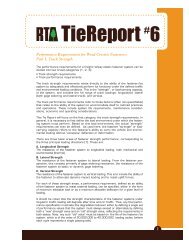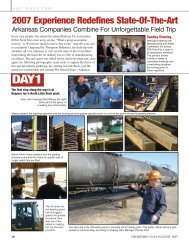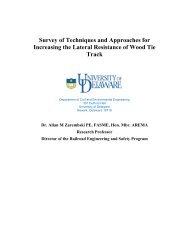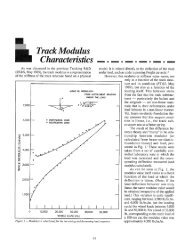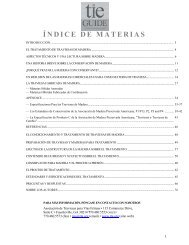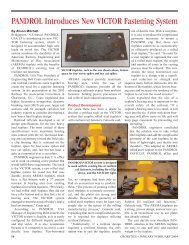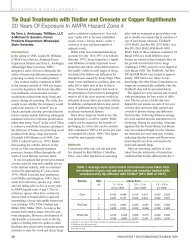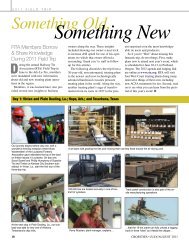creosote, its use as a wood preservative railroad transportation ...
creosote, its use as a wood preservative railroad transportation ...
creosote, its use as a wood preservative railroad transportation ...
Create successful ePaper yourself
Turn your PDF publications into a flip-book with our unique Google optimized e-Paper software.
CREOSOTE, ITS USE AS AWOOD PRESERVATIVEIn TheRAILROAD TRANSPORTATIONINDUSTRYWithENVIRONMENTAL CONSIDERATIONSPrepared ByDAVID A.WEBBChairman, Railway Tie Association Research & Development CommitteeAdministrative Director, Creosote Council IIP<strong>as</strong>t President, American Wood-Preservers' Association
IntroductionThe <strong>creosote</strong> pressure-treated <strong>wood</strong> crosstie h<strong>as</strong> been the very foundation of the North.3American <strong>railroad</strong>s for more than 125 years. 'Me <strong>use</strong> of <strong>creosote</strong> and <strong>its</strong> solutions with coal tar andheavy petroleum <strong>as</strong> a <strong>preservative</strong> for timber crossties, switch ties and bridge timbers is somewhatunique <strong>as</strong> compared to other pesticide products. These <strong>preservative</strong> materials are not broadc<strong>as</strong>tsprayed or otherwise widely distributed over large are<strong>as</strong> <strong>as</strong> often occurs with those pesticidesapplied to field crops.Creosote <strong>preservative</strong>s are pressure impregnated into <strong>wood</strong> materials, such <strong>as</strong> crossties,inside closed cylinder retorts. The pressure process represents over 99% of all the <strong>creosote</strong> treated<strong>wood</strong> products; while less than I% is applied with non-pressure methods.The <strong>use</strong> of <strong>creosote</strong> for the <strong>railroad</strong> <strong>transportation</strong> industry represents the major <strong>use</strong> of this<strong>preservative</strong>. The latest Wood Preservation Statistics - 1997 <strong>as</strong> prepared for the American Wood-Preservers' Association (AWPA) provides the following information concerning <strong>wood</strong> treated with<strong>creosote</strong> and <strong>its</strong> solutions; along with the other two major <strong>wood</strong> <strong>preservative</strong>s - oilborne andwaterborne systems.# Total volume of treated <strong>wood</strong> b<strong>as</strong>ed on production reports from a total of 454plants w<strong>as</strong> 728 million cubic feet– <strong>creosote</strong> and <strong>its</strong> solutions represent a total of 97 million cu. ft.(13.3%) of treated <strong>wood</strong> products (major <strong>use</strong> being crossties),1
– oilborne <strong>preservative</strong>s (predominately pentachlorophenol solutions)represent a total of 36 million cu. ft. (4.9%) of treated <strong>wood</strong> products(major <strong>use</strong> being utility poles),– waterborne <strong>preservative</strong>s (predominately CCA copper chrome arsenicsolutions) represent a total of 581 million cu. ft. (79.9%) of treated <strong>wood</strong>products (major <strong>use</strong> being lumber & timbers),# Major treated <strong>wood</strong> products, which accounts for 86% of the total production,were:– lumber & timbers: 478 million cu.ft. (98% treated with waterborne),– crossties, switch ties & bridge timbers: 82 million cu.ft. (nearly 100%with <strong>creosote</strong>),– utility poles: 64 million cu.ft. (49.5% with oilborne; 35.8% withwaterborne; and 14.6% with <strong>creosote</strong>).The proceeding information is to enable the reader to focus on the major <strong>use</strong>s of treated<strong>wood</strong> products and the three (3) major <strong>preservative</strong>s that are <strong>use</strong>d by the pressure treating <strong>wood</strong>industry. It should be considered that the three major <strong>preservative</strong>s <strong>creosote</strong>, oilborne (penta) andwaterborne arsenicals - are <strong>wood</strong> <strong>preservative</strong>s pesticides that are registered under FIFRA (FederalInsecticide Fungicide and Rodenticide Act), which is administered by the United StatesEnvironmental Protection Agency (EPA).Further it is important to note that all <strong>preservative</strong>s were reregistered in January of 19862
after an extensive eight year review by the EPA, After EPA's careful evaluation of the risks involvedwhen exposure to these <strong>wood</strong> <strong>preservative</strong> chemicals occurred, the agency concluded that therewould not be a significant risk to the applicator of these <strong>preservative</strong>s <strong>as</strong> long <strong>as</strong> specific labelmodifications were made. A part of this deliberation took into account the significant economic benef<strong>its</strong>which result from the <strong>use</strong> of these <strong>wood</strong> <strong>preservative</strong>s.The reregistation of the <strong>preservative</strong>s w<strong>as</strong> foc<strong>use</strong>d on the chemicals and their <strong>use</strong>s. There wereno restrictions placed on treated <strong>wood</strong> and <strong>its</strong> <strong>use</strong>. Subsequent Data-Call-In efforts by the EPA h<strong>as</strong>foc<strong>use</strong>d on what effect, if any, treated <strong>wood</strong> h<strong>as</strong> on the environment. A similar evaluation of the majorthree <strong>preservative</strong>s h<strong>as</strong> been ongoing by the Pest Management Regulatory Agency (PMRA) of HealthCanada.Creosote and Its Use ConsiderationsA major purpose of this paper is to provide some information concerning the effect of <strong>creosote</strong>treated <strong>wood</strong> products on the environment. In addition, however, there are some economic andspecific <strong>use</strong>s for <strong>creosote</strong> treated <strong>wood</strong> that need to be given consideration.The Railway Tie Association (RTA) publishes within their Crossties magazine informationwhich indicates trends for crosstie production, inventory and pricing of lumber and crossties(Figure 1). It should be noted that with an untreated tie priced at $18; cost of treatment with<strong>creosote</strong> being $9; thus the total cost of a treated crosstie3
without f<strong>as</strong>teners would be approaching $30. This information is of <strong>use</strong> in comparing the relative costof timber crossties <strong>as</strong> compared to alternative materials such <strong>as</strong> concrete, steel and pl<strong>as</strong>tic that havebeen <strong>use</strong>d in special situations <strong>as</strong> crosstie material. The production and inventory data indicates thetrend for supply and demand of crosstie materials.Within the Introduction Section Wood Preservation Statistics prepared for AWPA weresited for the volume of treated <strong>wood</strong> produced in 1997 for the three major <strong>preservative</strong>s - <strong>creosote</strong>,waterborne (CCA) and oilborne (penta) systems.Also tabulated from the Wood Preservation Statistics Report are data for the volume of<strong>creosote</strong> treated <strong>wood</strong> produced for the <strong>railroad</strong> industry in 1997. In the statistical survey a total of249 plants responded, which represents 72% of the estimated total volume of <strong>creosote</strong> treated<strong>wood</strong> (Table 1).The information given in Table 2 provides data on the volume of <strong>creosote</strong> treatment of <strong>wood</strong>crossties and switch ties. Since 1984 the number of <strong>creosote</strong> treated crossties h<strong>as</strong> fluctuated, butindicates a trend toward A "mature" market for crossties. As reported in 1997, 75,939M cubicfeet (this represents about 19 million crossties) were produced. Of that number, it is estimated thatsomething on the order of 75% of those crossties were <strong>use</strong>d by the Cl<strong>as</strong>s I Railroads; with the other25% <strong>use</strong>d by the Shortline Railroads and Construction Companies.Data given in the two Tables provides information in 1,000 Cubic Feet of treated <strong>wood</strong>. Inaddition, the following statements need to be considered when reviewing the information:4
# The standard crosstie dimension is 7x9 inches in cross-section and eight (8) andone-half feet in length (which gives a total of 3.7 cubic feet per crosstie). Thereare however, variations <strong>as</strong> often tie material will be cut to a cross-section of 6x8inches with a length of nine (9) feet Also the 7x9 inch tie can be nine (9) feet inlength. Some of the Cl<strong>as</strong>s I's will accept a certain percentage of 6x8s, e.g. "not toexceed 10% of the total within the shipment"# Of the three <strong>creosote</strong> treated products - crossties, switch ties and timbers - theirpercentage of the market is respectively - 92%, 7% and 1%Creosote Treated Wood and Its Effect on the EnvironmentThe <strong>use</strong> of <strong>creosote</strong> <strong>as</strong> a <strong>wood</strong> <strong>preservative</strong> is well documented within the Proceedings ofAmerican Wood-Preservers' Association (AWPA). The development of the <strong>wood</strong> preservingindustry within North America and throughout the world h<strong>as</strong> historically been b<strong>as</strong>ed on the need toprotect nondurable <strong>wood</strong> species from <strong>wood</strong> destroying organisms. During the late 19th century, the<strong>railroad</strong>s, which were involved in a vigorous construction program to link the major industrial cities inNorth America, were using naturally durable timbers such <strong>as</strong> black locust, cedar, chestnut, and whiteoak. Ultimately, it w<strong>as</strong> not possible to utilize naturally durable timbers beca<strong>use</strong> they simply were notavailable in sufficient, cost effective, quantities to meet the demand of the <strong>railroad</strong>s.5
A similar statement can be made for the potential <strong>use</strong> within the <strong>railroad</strong> <strong>transportation</strong>industry of alternative materials for crossties. These materials include concrete, pl<strong>as</strong>tics and steel ties.They must be "cost effective." Concrete crossties are not giving the estimated service life of 50 years,which w<strong>as</strong> promoted by the producing industry. Ties in the North E<strong>as</strong>t Corridor are being replaced insome instances after only ten years in-track.Wood is a renewable resource. It is the only structural material that is renewable. This resourceh<strong>as</strong>, for the most part, in North America been managed to sustain <strong>its</strong>elf; it h<strong>as</strong> been renewable. In directcontr<strong>as</strong>t, Continental Europe h<strong>as</strong> not managed <strong>its</strong> forest resource in a manner to provide <strong>wood</strong>products. This is the specific re<strong>as</strong>on that concrete crosstie material must be <strong>use</strong>d for the rail systems inEurope. There is not <strong>wood</strong> available for <strong>use</strong> <strong>as</strong> crosstie material.The <strong>use</strong> of <strong>creosote</strong> for preserving <strong>wood</strong> can be considered the oldest of the three major<strong>preservative</strong>s that is being <strong>use</strong>d in North America. The treatment of <strong>wood</strong> <strong>railroad</strong> crossties with<strong>creosote</strong> w<strong>as</strong> first initiated with the Bethel full-cell pressure treatment process at the Somerset,M<strong>as</strong>sach<strong>use</strong>tts plant in 1865. Twelve years later, the Louisville and N<strong>as</strong>hville Railroad treating plantw<strong>as</strong> built in P<strong>as</strong>cagoula, Mississippi. Construction of these plants is considered the beginning of themodem pressure treating industry in North America.The <strong>use</strong> of <strong>creosote</strong> <strong>as</strong> a <strong>wood</strong> <strong>preservative</strong> for both pressure and non-pressure processesh<strong>as</strong> been well documented in the AWPA Proceedings. It is not the intent of this brief paper todescribe <strong>creosote</strong>, it's solution and serviceability, however, it is the6
intent to discuss some of the environmental effects of <strong>creosote</strong> treated <strong>wood</strong> products.It is somewhat ironical that the <strong>wood</strong> preserving industry h<strong>as</strong> developed significant volumes ofinformation concerning the service-life performance of <strong>its</strong> treated <strong>wood</strong> products. However, the industryhad not developed, prior to the 1990's, a significant amount of information concerning the environmentaleffects of <strong>creosote</strong> treated <strong>wood</strong> products. The following pre- I 990's information is cited for referencepurposes concerning the environmental effects of <strong>creosote</strong> treated <strong>wood</strong>:# Von Rumker, et al. (1975), in a report for the United States EPA, stated that theevidence available indicated that the environmental hazards posed by <strong>creosote</strong>treated products were minimal. They cited reports characterizing the loss of<strong>creosote</strong> constituents by vaporization from the treated <strong>wood</strong> <strong>as</strong> compared to theloss of similar PNA compounds, and in much greater quantities, that occur frompine forests.# Wade, et al. (1987), evaluated water samples taken adjacent to <strong>creosote</strong> marinepiling. Samples of water were taken from the surface sheen, the water column,and the bottom sediment. The water samples were analyzed using two procedures:– acute toxicity test with sea urchin, Areachia punctulata,– m<strong>as</strong>s spectrophotometric g<strong>as</strong> chromatography (MSGC) analyses.The MSGC analyses showed the presence of <strong>creosote</strong> components in the watersurface sheen samples. There w<strong>as</strong> no identifiable compounds found in the watercolumn sample. In addition there w<strong>as</strong> no me<strong>as</strong>urable toxicity in the water column7
when the sea urchins were exposed.# The movement of <strong>creosote</strong> components from a treated <strong>wood</strong> utility pole into thesurrounding soil is considered to be negligible. A study conducted at Mississippi StateUniversity (1975) found none of the major <strong>creosote</strong> components in soil samplescollected to a depth of six (6) inches and ranging from two (2) to twentyfour (24)inches from the pole. The <strong>creosote</strong> components either oxidized or biodegraded.# Several other studies support the fact that <strong>creosote</strong> components are readilybiodegradable. These studies included the work by Bel<strong>as</strong>t, et al. (1979) and Seeman, etat. (1977) which reported on the biodegradation of <strong>creosote</strong>/naphthalene treated timberpiling. In addition, researchers at the United States Naval Civil Engineering Laboratoryspecially identified the metabolism of <strong>creosote</strong> (biodegradation) with certain marinemicro-organisms. The research w<strong>as</strong> conducted by Drisko, et al. (1962) and (1966).# Several researchers have summarized the effects of migration and mitigation of<strong>preservative</strong> from <strong>creosote</strong> treated <strong>wood</strong> products in the environment - Davis, et al.(1993), and Lamar and Kirk (1994). The later two researchers summarized the resultsof many projects and conclude the microbiological treatments may be <strong>use</strong>d <strong>as</strong>remediation of <strong>creosote</strong> contaminated soils.# It is also important to consider the ubiquitous nature of <strong>creosote</strong> components, whichoften are common and abundant in the soil. Blumer (1961) found isomers8
of benzopyrene in soil samples collected in rural are<strong>as</strong> of M<strong>as</strong>sach<strong>use</strong>tts and Connecticut. Alsopresent in the samples were other PNA compounds, which included phenanthrene, anthracene,pyrene, chrysene, and fluorenthene (also found in <strong>creosote</strong>). Conclusion w<strong>as</strong> that these PNAcompounds are indigenous to the soil and probably occur <strong>as</strong> a result of <strong>wood</strong> pyrolysis andbiological degradation of plant tissue.Summary StatementAlthough the information given in this paper is somewhat empirical, the evidence indicates that<strong>creosote</strong> treated <strong>wood</strong> products do not present an unre<strong>as</strong>onable health risk to man, animals, or havesignificant environmental effects. Creosote treated <strong>wood</strong> products can be safely <strong>use</strong>d with properprecautions. As with many other materials, <strong>use</strong>rs of <strong>creosote</strong> treated <strong>wood</strong> need to <strong>use</strong> common sense<strong>use</strong> and handling practices. It is noteworthy that Goyette and Brooks (1999) have confirmed some ofWade's findings in their Canadian Sooke B<strong>as</strong>in Creosote Study. However, their study w<strong>as</strong> much moredetailed and it evaluated and found PNA materials in the bottom sediment in "close proximity" to the<strong>creosote</strong> piling. However, there does appear to be some biodegradation occurring with the PNAmaterials in the sediment near the piling of the Sooke B<strong>as</strong>in Creosote Study.9
Figure 1Crosstie Production/Inventory/Ha rd<strong>wood</strong> Trend Pricing<strong>as</strong> Compared with 4/4 2A Red Oak PricingNOTES: * Tie production and inventory are shown along with "green" 4/4 2A Red Oak in a six-month moving average format. This results inminimized monthly deviations and more clearly illustrates long-term trends. See chart below for actual tic production and inventory data.* "Green" 4/4 2A Red Oak is considered a re<strong>as</strong>onable benchmark to compare with historical tie price movement. This data represents a "trend" linedeveloped from a composite of all reporting regions, compiled with permission from and in cooperation with the Hard<strong>wood</strong> Market Report.* The tie trend price line is just that-a trend line. The graph illustrates a composite number that reflects a consistent ratio between the high and lowprices reported in tile Hard<strong>wood</strong> Market Report for all reported regions. For this re<strong>as</strong>on, the line is only representative of trends, not actual pricing.See facing page for individualregional trend lines.Ple<strong>as</strong>e note, with all "trend" lines,that in the real world of hard<strong>wood</strong>lumber and tie markets tile pricesfluctuate, sometimes significantly,from week to week. All informationpresented in these graphs should beconsidered in the light of the mostcurrent pricing available. For actualreported weekly pricing, you maysubscribe to:Hard<strong>wood</strong> Market Report(901) 767-9126
TABLE IVOLUME OF WOOD TREATED* FORRAILROAD INDUSTRY IN 1997(Only includes production from 249 reporting plants)1,000 Cubic Feet % of TotalCrossties 55,611 78Switch Ties 49.382 6Timbers** 1,062 1Not treated for RailroadsAll Other Wood Products*** 109268 15*Creosote and Its Solutions**Sawn timber products whose le<strong>as</strong>t dimension is five (5) inches or5x7, 6x8, etc.)***Includes poles, piling, fence posts, etc.more (e.g.
TABLE 2TRENDS IN THE TREATMENT OFWOOD CROSSTIES AND SWITCH TIES1997 1993 1990 1987 1984( 1, 000 Cubic Feet)Crossties 75,939 63,586 62,988 59,594 88,720Switch Ties 5,988 6,611 7,165 91306 89198Timbers*(not trackable due to influence of waterborne <strong>preservative</strong> treatment;however, note Table I for estimates for <strong>creosote</strong> treated timbers)It should be noted that the majority of all <strong>railroad</strong> <strong>wood</strong> products are pressure treated with<strong>creosote</strong> meeting the American Wood-Preservers' Association (AWPA) Standards forCreosote, P1/P13; Creosote Solution, P2; and Creosote-Petroleum Oil Solution, P3.For the treatment of crossties and switch ties the United States <strong>creosote</strong> treating plantse<strong>as</strong>t of the Mississippi <strong>use</strong> Creosote Solution, P2; while Canadian and Western USplants often <strong>use</strong> Creosote-Petroleum Oil Solution, P3.Bridge Timbers have generally been treated with Creosote meeting AWPA, P1/P13Standard.* Sawn timber products whose le<strong>as</strong>t dimension is five (5) inches or more (eg. 5x7, 6x8etc.)**Micklewright, J. T. 1998. "Wood Preservation Statistics - 1997.Prepared for the American Wood-Preservers' Association.
LITERATURE CITEDBel<strong>as</strong>, M. R.; A. Zachary,; K_ Allen; B. Austin and R. R. Colwell. 1979. Microbial Colonization ofNaphthalene/Creosote-Treated Wood Pilings in a Tropical Marine Environment. AWPA Proceedings72:20-27.Blumer, M. 196 1. Benzpyrenes in Soil. Science 134:474-475.Crossties Magazine. May/June 1999. Published for the Railway Tie Association, Fayetteville, GAby Covey Communications Corporation, Gulf Shores, AL.Davis, M. W.; J. A. Gl<strong>as</strong>er; J. W. Evans; R. T. Lamar. 1993. Field Evaluation of the Lignin-Degrading Fungus Phanerochaete sordida to Treat CreosoteContaminated Soil. EnvironmentalScience and Technology 27(12): pp 2572-2576.Drisko, R. W. and T. B. O'Neil. 1966. Forest Products Journal Vol. 16, No. 7.Drisko, R. W.; T. B. O'Neil and H. Hochman. 1962. Metabolism of Creosote by Certain MarineMicro-Organisms. Technical Report R-230, U.S. Naval Civil Engineering Laboratory, Port.Hueneme, CA.Goyette, D. and K. Brooks. 1999. Sooke B<strong>as</strong>in Creosote Evaluation Study. EnvironmentCanada, Pacific & Yukon Region, North Vancouver, BC.Lamar, R. T. and T. K. Kirk. 1994. Remediation of Pentachlorophenol and CreosoteContaminated Soils Using Wood-Degrading Fungi. The International Research Group on WoodPreservation, Section 5. Environmental Aspects. Document IRG/WP 94-50021. 9p.Micklewright, J. T. 1998. Wood Preservation Statistics - 1997. Prepared for the American Wood-Preservers' Association (AWPA), Granbury, TX.Mississippi State University. 1975. Unpublished Data in the Files of the Mississippi Forest ProductsLaboratory, Mississippi State University, State College, Mississippi.10
Seesman, P. A.; R. R. Colwell and A. Zachary. 1977. Biodegradation ofCreosote/Naphthalene-Treated Wood in the Marine Environment. AWPA Proceedings,73:54-63.von Rumker; R. E. W. Lawless and A. F. Minersa. 1975. C<strong>as</strong>e Study No. 20. Creosote. InProduction Distribution and Environmental Impact Potential of Selected Pesticides. U.S.Environmental Protection Agency Report No. 540/1-74001.Wade, M. J.; M. S. Connor; K. M. Jop; R. E. Hillman and H. J. Costa. 1987. SummaryEvaluation of the Environmental Impact Resulting from the Use of Creosoted Pilings in the HistoricRestoration of Pier #2 at the Charlestown Navy Yard. A Report U.S. Dept. Of Interior, NationalPark Service, prepared by Battelle Ocean Sciences, Duxbury, MA.Webb, D. A. and L. R. Gjovik. 1988. Treated Wood Products, Their Effect on the Environment.AWPA Proceedings No. 81:254-259.





